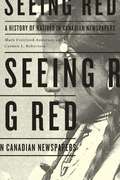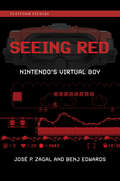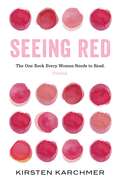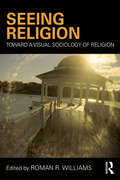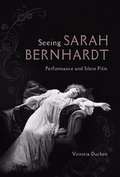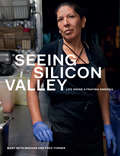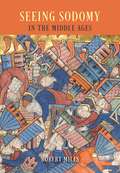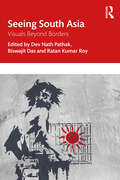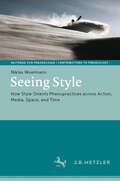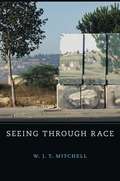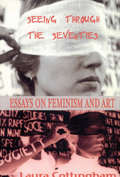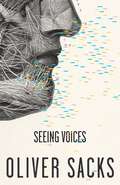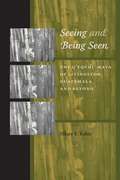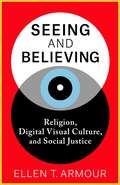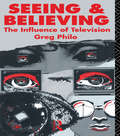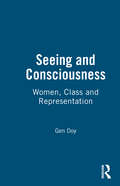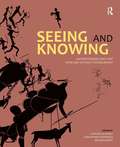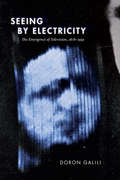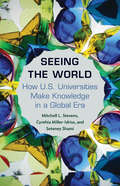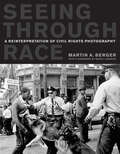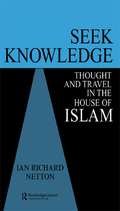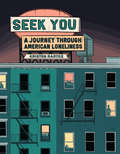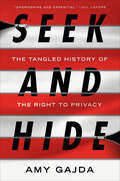- Table View
- List View
Seeing Red: A History of Natives in Canadian Newspapers
by Carmen L. Robertson Mark Cronlund AndersonThe first book to examine the role of Canada’s newspapers in perpetuating the myth of Native inferiority. Seeing Red is a groundbreaking study of how Canadian English-language newspapers have portrayed Aboriginal peoples from 1869 to the present day. It assesses a wide range of publications on topics that include the sale of Rupert’s Land, the signing of Treaty 3, the North-West Rebellion and Louis Riel, the death of Pauline Johnson, the outing of Grey Owl, the discussions surrounding Bill C-31, the “Bended Elbow” standoff at Kenora, Ontario, and the Oka Crisis. The authors uncover overwhelming evidence that the colonial imaginary not only thrives, but dominates depictions of Aboriginal peoples in mainstream newspapers. The colonial constructs ingrained in the news media perpetuate an imagined Native inferiority that contributes significantly to the marginalization of Indigenous people in Canada. That such imagery persists to this day suggests strongly that our country lives in denial, failing to live up to its cultural mosaic boosterism.
Seeing Red: Nintendo's Virtual Boy (Platform Studies)
by Jose P. Zagal Benj EdwardsThe curious history, technology, and technocultural context of Nintendo&’s short-lived stereoscopic gaming console, the Virtual Boy.With glowing red stereoscopic 3D graphics, the Virtual Boy cast a prophetic hue: Shortly after its release in 1995, Nintendo's balance sheet for the product was "in the red" as well. Of all the innovative long shots the game industry has witnessed over the years, perhaps the most infamous and least understood was the Virtual Boy. Why the Virtual Boy failed, and where it succeeded, are questions that video game experts José Zagal and Benj Edwards explore in Seeing Red, but even more interesting to the authors is what the platform actually was: what it promised, how it worked, and where it fit into the story of gaming.Nintendo released the Virtual Boy as a standalone table-top device in 1995—and quickly discontinued it after lackluster sales and a lukewarm critical reception. In Seeing Red, Zagal and Edwards examine the device's technical capabilities, its games, and the cultural context in the US in the 1990s when Nintendo developed and released the unusual console. The Virtual Boy, in their account, built upon and extended an often-forgotten historical tradition of immersive layered dioramas going back 100 years that was largely unexplored in video games at the time. The authors also show how the platform's library of games conveyed a distinct visual aesthetic style that has not been significantly explored since the Virtual Boy's release, having been superseded by polygonal 3D graphics. The platform's meaning, they contend, lies as much in its design and technical capabilities and affordances as it does in an audience's perception of those capabilities. Offering rare insight into how we think about video game platforms, Seeing Red illustrates where perception and context come, quite literally, into play.
Seeing Red: The One Book Every Woman Needs to Read. Period.
by Kirsten KarchmerA world-renowned women&’s health expert reveals a bold, practical, and data-driven handbook for menstrual periods that provides an easy-to-navigate roadmap for improving your reproductive health—and your everyday quality of life.We&’ve been lied to about periods. PMS, cramping, bloating, migraines, irritability, and anxiety may be extremely common, but contrary to popular belief, they aren&’t normal. And they certainly aren&’t &“just part of being a woman,&” despite the fact that this is what we&’ve been told time and time again—by friends, family, and even doctors. After dedicating her entire clinical career to deconstructing the menstrual cycle, women&’s health expert Kirsten Karchmer knows better. During her more than twenty years of research and treating thousands of patients, Karchmer found that most period problems women experience—even the most painful ones—are totally correctable and more surprisingly reflective of overall health and fertility. In this forthright, spirited, and all-encompassing guide, Karchmer draws on her decades&’ worth of experience as a women&’s health expert to break down the myths so many women have been led to believe about their periods. For the more than 82 million women in the world who suffer from menstrual conditions, Seeing Red explains the importance of a healthy menstrual cycle (and how to achieve it) and why it is important to the women&’s movement. Menstrual cycles are not a curse, but an instrument providing women with one of the most valuable, regularly occurring, and free diagnostic tools they have, giving them access to unprecedented health and power.
Seeing Religion: Toward a Visual Sociology of Religion (Routledge Advances in Sociology)
by Roman R. WilliamsThe potential of visual research methods in the sociology of religion is vast, but largely untapped. This comes as a surprise, however, given the visual, symbolic, and material nature of religion and spirituality. Evidence of religious faith and practice is materially present in everything from clothing and jewelry to artifacts found in people’s homes and workplaces. Not only is religion’s symbolic and material presence palpable throughout society, it also informs attitudes, beliefs, and behaviors of countless people worldwide. Words-and-numbers approaches to social research, however, sometimes miss important dimensions of religion and spirituality in the contemporary world. Seeing Religion is an invitation to a visual sociology of religion. Contributors draw from their current research to discuss the application of visual methods to the study of religion and spirituality. Each chapter stimulates the sociological imagination through examples of research techniques, analytical approaches, and methodological concerns.
Seeing Sarah Bernhardt: Performance and Silent Film
by Victoria DuckettThe most famous stage actress of the nineteenth century, Sarah Bernhardt enjoyed a surprising renaissance when the 1912 multi-reel film Queen Elizabeth vaulted her to international acclaim. The triumph capped her already lengthy involvement with cinema while enabling the indefatigable actress to reinvent herself in an era of technological and generational change. Placing Bernhardt at the center of the industry's first two decades, Victoria Duckett challenges the perception of her as an anachronism unable to appreciate film's qualities. Instead, cinema's substitution of translated title cards for her melodic French deciphered Bernhardt for Anglo-American audiences. It also allowed the aging actress to appear in the kinds of longer dramas she could no longer physically sustain onstage. As Duckett shows, Bernhardt contributed far more than star quality. Her theatrical practice on film influenced how the young medium changed the visual and performing arts. Her promoting of experimentation, meanwhile, shaped the ways audiences looked at and understood early cinema. A leading-edge reappraisal of a watershed era, Seeing Sarah Bernhardt tells the story of an icon who bridged two centuries--and changed the very act of watching film.
Seeing Silicon Valley: Life inside a Fraying America
by Mary Beth Meehan Beth MeehanAcclaimed photographer Mary Beth Meehan and Silicon Valley culture expert Fred Turner join forces to give us an unseen view of the heart of the tech world. It’s hard to imagine a place more central to American mythology today than Silicon Valley. To outsiders, the region glitters with the promise of extraordinary wealth and innovation. But behind this image lies another Silicon Valley, one segregated by race, class, and nationality in complex and contradictory ways. Its beautiful landscape lies atop underground streams of pollutants left behind by decades of technological innovation, and while its billionaires live in compounds, surrounded by redwood trees and security fences, its service workers live in their cars. With arresting photography and intimate stories, Seeing Silicon Valley makes this hidden world visible. Instead of young entrepreneurs striving for efficiency in minimalist corporate campuses, we see portraits of struggle—families displaced by an impossible real estate market, workers striving for a living wage, and communities harmed by environmental degradation. If the fate of Silicon Valley is the fate of America—as so many of its boosters claim—then this book gives us an unvarnished look into the future.
Seeing Sodomy in the Middle Ages
by Robert MillsDuring the Middle Ages in Europe, some sexual and gendered behaviors were labeled “sodomitical” or evoked the use of ambiguous phrases such as the “unmentionable vice” or the “sin against nature.” How, though, did these categories enter the field of vision? How do you know a sodomite when you see one? In Seeing Sodomy in the Middle Ages, Robert Mills explores the relationship between sodomy and motifs of vision and visibility in medieval culture, on the one hand, and those categories we today call gender and sexuality, on the other. Challenging the view that ideas about sexual and gender dissidence were too confused to congeal into a coherent form in the Middle Ages, Mills demonstrates that sodomy had a rich, multimedia presence in the period—and that a flexible approach to questions of terminology sheds new light on the many forms this presence took. Among the topics that Mills covers are depictions of the practices of sodomites in illuminated Bibles; motifs of gender transformation and sex change as envisioned by medieval artists and commentators on Ovid; sexual relations in religious houses and other enclosed spaces; and the applicability of modern categories such as “transgender,” “butch” and “femme,” or “sexual orientation” to medieval culture. Taking in a multitude of images, texts, and methodologies, this book will be of interest to all scholars, regardless of discipline, who engage with gender and sexuality in their work.
Seeing South Asia: Visuals Beyond Borders
by Dev Nath Pathak, Biswajit Das and Ratan Kumar RoyThis book critically examines the cultural politics of visuals in South Asia. It makes a key contribution to the study of visuals in the social sciences in South Asia by studying the interplay of the seen and unseen, and the visual and nonvisual. The volume explores interrelated themes including the vernacular visual and visuality, ways of seeing in South Asia and the methodology of hermeneutic sensorium, anxiety and politics of the visuals across the region and the trajectory of visual anthropology, significance of visual symbols and representations in contemporary performances and folk art, visual landscapes of loss and recovery and representation of refugees, visual public in South Asia and making of visuals for contemporary consumptions. The chapters unravel the concepts of visual, visibility, visuality while attending to determinant meta-ideas, such as memory and modernity, trajectories of tradition, fluidity and hybridity, and visual performative politics. Based on interdisciplinary resources, the chapters in this volume present a wide array of empirical findings across India, Pakistan, Sri Lanka, Nepal and Bangladesh, along with analytical readings of the visual culture of the subcontinent across borders. The book will be useful to scholars and researchers of visual and cultural studies, social and cultural anthropology, sociology, political studies, media and communications studies, performance studies, art history, television and film studies, photography studies, and South Asian studies. It will also interest practitioners including artists, visual artists, photographers, filmmakers and media critics.
Seeing Style: How Style Orients Phenopractices across Action, Media, Space, and Time (Beiträge zur Praxeologie / Contributions to Praxeology)
by Niklas WoermannHow do social practices prefigure experiences, and how does embodied experience organize the performance of practices? This book suggests that the classic concept of style offers a fresh answer to the question how doings and sayings are linked into practice bundles. Based on a rich ethnographic study of the visual practices of the German-speaking freeskiing subculture, this work develops a theory of phenopractices, or embodied cultural practices dedicated to apprehending and expressing style. Focusing on the visual dimension, it extends the thought of Garfinkel and Schatzki using recent insights from science and technology studies and research at the intersection of neuroscience and phenomenology. This offers a new perspective on fundamental practice-theoretical questions about the nature of practice elements, social order in the context of rules and regularity, or action and practical intelligibility. Each chapter discusses and develops foundational concepts such as time, space, action, emotion, or perception based on an analysis of freeskiing practices such as planning a route in the backcountry, testing a new ski model, or judging freestyle contests. The central argument is that cultural styles of conduct are not only symbolic structures, but a functional resource which organizes situational intelligibility and thus enables social order based on aligned and managed embodied routines. Because the stabilization, dissemination, and evolution of such styles happens via different media, practice change is primarily influenced by media rather than symbolic, rational, or functional needs or ends. A rich ethnography and provocative theoretical argument of interest to anyone working on contemporary practice thought, advancing phenomenology, the sociology of vision, lifestyle sports, media, or practice evolution.
Seeing Through Race
by Mitchell W. J. T.According to W. J. T. Mitchell, a color-blind post-racial world is neither achievable nor desirable. Against popular claims that race is an outmoded construct that distracts from more important issues, Mitchell contends that race remains essential to our understanding of social reality. Race is not simply something to be seen but is among the fundamental media through which we experience human otherness. Race also makes racism visible and is thus our best weapon against it. The power of race becomes most apparent at times when pedagogy fails, the lesson is unclear, and everyone has something to learn. Mitchell identifies three such moments in America’s recent racial history. First is the post–Civil Rights moment of theory, in which race and racism have been subject to renewed philosophical inquiry. Second is the moment of blackness, epitomized by the election of Barack Obama and accompanying images of blackness in politics and popular culture. Third is the Semitic Moment in Israel-Palestine, where race and racism converge in new forms of anti-Semitism and Islamophobia. Mitchell brings visual culture, iconology, and media studies to bear on his discussion of these critical turning points in our understanding of the relation between race and racism.
Seeing Through Race (The\w. E. B. Du Bois Lectures #11)
by W. J. MitchellAccording to Mitchell, a “color-blind” post-racial world is neither achievable nor desirable. Against claims that race is an outmoded construct, he contends that race is not simply something to be seen but is a fundamental medium through which we experience human otherness. Race also makes racism visible and is thus our best weapon against it.
Seeing Through the Seventies: Essays on Feminism and Art (Critical Voices In Art, Theory, Culture Ser.)
by Laura CottinghamIn recent years, Laura Cottingham has emerged as one of the most visible feminist critics of the so-called post-feminist generation. Following a social-political approach to art history and criticism that accepts visual culture as part of a larger social reality, Cottingham's writings investigate central tensions currently operative in the production, distribution and evaluation of art, especially those related to cultural production by and about women.Seeing Through the Seventies: Essays on Feminism and Art gathers together Cottingham's key essays from the 1990's. These include an appraisal of Lucy R. Lippard, the most influential feminist art critic of the1970's; a critique of the masculinist bias implicit to modernism and explicitly recuperated by commercially successful artists during the 1980s; an exhaustive analysis of the curatorial failures operative in the "Bad Girls" museum exhibitions of the early 1990s; surveys of feminist-influenced art practices during the women's liberationist period; speculations on the current possibilities and obstacles that attend efforts to recover lesbian cultural history; and an examination of the life, work and obscuration of the early twentieth-century French photographer Claude Cahun.
Seeing Voices: A Journey into the World of the Deaf
by Oliver SacksSign language is, in the hands of its masters, a most beautiful and expressive language.
Seeing and Being Seen: The Q'eqchi' Maya of Livingston, Guatemala, and Beyond
by Hilary E. KahnThe practice of morality and the formation of identity among an indigenous Latin American culture are framed in a pioneering ethnography of sight that attempts to reverse the trend of anthropological fieldwork and theory overshadowing one another.<P><P>In this vital and richly detailed work, methodology and theory are treated as complementary partners as the author explores the dynamic Mayan customs of the Q'eqchi' people living in the cultural crossroads of Livingston, Guatemala. Here, Q'eqchi', Ladino, and Garifuna (Caribbean-coast Afro-Indians) societies interact among themselves and with others ranging from government officials to capitalists to contemporary tourists.
Seeing and Believing: Religion, Digital Visual Culture, and Social Justice
by Ellen T. ArmourSocial media platforms are often denounced as “bubbles” or “echo chambers.” In this view, what we see tends to reinforce what we already believe, and what we already believe shapes what we see. Yet social movements such as Black Lives Matter rely heavily on the widespread dissemination of digital photographs and videos through social media. In at least some cases, visual images can challenge normative and normalized ways of grasping the world and prompt their viewers to see differently—and even bring people together.Seeing and Believing marshals religious resources to recast the significance of digital images in the struggle for social justice. Ellen T. Armour examines what distinguishes digital photography from its analogue predecessor and places the circulation of digital images in the broader context of virtual visual cultures. She explores the challenges and opportunities that visually saturated social media landscapes present for users and organizers. Despite the power of digital platforms and algorithms, possibilities for disruption and resistance emerge from how people engage with these systems. Armour offers ways of seeing drawn from Christianity and found in other religious traditions to help us break with entrenched habits and rethink how we engage with the images that grab our attention. Developing theological perspectives on the power and peril of photography and technology, Seeing and Believing provides suggestions for navigating the new media landscape that can spark what Armour calls “photographic insurrection.”
Seeing and Believing: The Influence of Television (Communication and Society)
by Greg PhiloTelevision has a powerful impact on our beliefs and is open to use as a political and propaganda tool. Greg Philo has taken a new approach to examining these issues by inviting groups of television viewers to write their own news programmes, based on news pictures from the 1984-5 British miners' strike.
Seeing and Consciousness: Women, Class and Representation
by Gen DoyThrough its provocative examination of feminist and Marxist approaches to women's art and female representations, this book challenges the widespread belief that Marxism has nothing valuable to contribute to women's studies. The author argues that, from the French Revolution through to the present, gender and class have shaped visual imagery. She shows how Marxist theory can function to question some of the premises of feminist art histories and to provide a more accurate understanding of the meaning(s) of visual imagery.
Seeing and Knowing: Understanding Rock Art with and without Ethnography
by Geoffrey Blundnell Christopher Chippindale Benjamin SmithThe purpose of Seeing and Knowing is to demonstrate the depth and wide geographical impact of David Lewis-Williams’ contribution to rock art research by emphasizing theory and methodology drawn from ethnography. Contributors explore what it means to understand and learn from rock art, and a contrast is drawn between those sites where it is possible to provide a modern, ethnographic context, and those sites where it is not. This is the definitive guide to the interplay between ethnography and rock art interpretation, and is an ideal resource for students and researchers alike.
Seeing by Electricity: The Emergence of Television, 1878-1939 (Sign, Storage, Transmission)
by Doron GaliliAlready in the late nineteenth century, electricians, physicists, and telegraph technicians dreamed of inventing televisual communication apparatuses that would “see” by electricity as a means of extending human perception. In Seeing by Electricity Doron Galili traces the early history of television, from fantastical image transmission devices initially imagined in the 1870s such as the Telectroscope, the Phantoscope, and the Distant Seer to the emergence of broadcast television in the 1930s. Galili examines how televisual technologies were understood in relation to film at different cultural moments—whether as a perfection of cinema, a threat to the Hollywood industry, or an alternative medium for avant-garde experimentation. Highlighting points of overlap and divergence in the histories of television and cinema, Galili demonstrates that the intermedial relationship between the two media did not start with their economic and institutional rivalry of the late 1940s but rather goes back to their very origins. In so doing, he brings film studies and television studies together in ways that advance contemporary debates in media theory.
Seeing the World: How US Universities Make Knowledge in a Global Era
by Mitchell L. Stevens Cynthia Miller-Idriss Seteney ShamiAn in-depth look at why American universities continue to favor U.S.-focused social science research despite efforts to make scholarship more cosmopolitanU.S. research universities have long endeavored to be cosmopolitan places, yet the disciplines of economics, political science, and sociology have remained stubbornly parochial. Despite decades of government and philanthropic investment in international scholarship, the most prestigious academic departments still favor research and expertise on the United States. Why? Seeing the World answers this question by examining university research centers that focus on the Middle East and related regional area studies.Drawing on candid interviews with scores of top scholars and university leaders to understand how international inquiry is perceived and valued inside the academy, Seeing the World explains how intense competition for tenure-line appointments encourages faculty to pursue “American” projects that are most likely to garner professional advancement. At the same time, constrained by tight budgets at home, university leaders eagerly court patrons and clients worldwide but have a hard time getting departmental faculty to join the program. Together these dynamics shape how scholarship about the rest of the world evolves.At once a work-and-occupations study of scholarly disciplines, an essay on the formal organization of knowledge, and an inquiry into the fate of area studies, Seeing the World is a must-read for anyone who cares about the future of knowledge in a global era.
Seeing through Race: A Reinterpretation of Civil Rights Photography
by Martin A. BergerSeeing through Race is a boldly original reinterpretation of the iconic photographs of the black civil rights struggle. Martin A. Berger’s provocative and groundbreaking study shows how the very pictures credited with arousing white sympathy, and thereby paving the way for civil rights legislation, actually limited the scope of racial reform in the 1960s. Berger analyzes many of these famous images—dogs and fire hoses turned against peaceful black marchers in Birmingham, tear gas and clubs wielded against voting-rights marchers in Selma—and argues that because white sympathy was dependent on photographs of powerless blacks, these unforgettable pictures undermined efforts to enact—or even imagine—reforms that threatened to upend the racial balance of power.
Seek Knowledge: Thought and Travel in the House of Islam
by Ian Richard NettonExplores various facets of the Islamic search for knowledge, with essays on aspects of Thought or Travel.
Seek You: A Journey Through American Loneliness (Pantheon Graphic Library)
by Kristen RadtkeFrom the acclaimed author of Imagine Wanting Only This—a timely and moving meditation on isolation and longing, both as individuals and as a societyThere is a silent epidemic in America: loneliness. Shameful to talk about and often misunderstood, loneliness is everywhere, from the most major of metropolises to the smallest of towns. In Seek You, Kristen Radtke's wide-ranging exploration of our inner lives and public selves, Radtke digs into the ways in which we attempt to feel closer to one another, and the distance that remains. Through the lenses of gender and violence, technology and art, Radtke ushers us through a history of loneliness and longing, and shares what feels impossible to share. Ranging from the invention of the laugh-track to the rise of Instagram, the bootstrap-pulling cowboy to the brutal experiments of Harry Harlow, Radtke investigates why we engage with each other, and what we risk when we turn away. With her distinctive, emotionally-charged drawings and deeply empathetic prose, Kristen Radtke masterfully shines a light on some of our most vulnerable and sublime moments, and asks how we might keep the spaces between us from splitting entirely. <P><P><i>Advisory: Bookshare has learned that this book offers only partial accessibility. We have kept it in the collection because it is useful for some of our members. Benetech is actively working on projects to improve accessibility issues such as these.</i>
Seek and Hide: The Tangled History of the Right to Privacy
by Amy Gajda&“This brilliant and thought-provoking book shows how America&’s well-known emphasis on freedom of the press has long been balanced by a deep legal tradition that protects an individual&’s right to privacy. Amy Gajda shows how battles over the right to privacy are nothing new, but they are particularly relevant in this era of digital media and social networks.&”—Walter Isaacson, author of Steve JobsAn urgent book for today's privacy wars: the surprising history of the fitful development of the right to privacy—and its battle against the public&’s right to know.The battle between an individual&’s right to privacy and the public&’s right to know has been fought for centuries. The founders demanded privacy for all the wrong press-quashing reasons. Supreme Court justice Louis Brandeis famously promoted First Amendment freedoms but argued strongly for privacy too; and presidents from Thomas Jefferson through Donald Trump confidently hid behind privacy despite intense public interest in their lives. Today privacy seems simultaneously under siege and surging. And that&’s doubly dangerous, as legal expert Amy Gajda argues. Too little privacy can mean extraordinary profits and power for people who deal in and publish soul-crushing secrets. Too much means the famous and infamous can cloak themselves in secrecy. Seek and Hide carries us from the very start, when privacy concepts first entered American law and society, to now, when the law allows a Silicon Valley titan to destroy a media site like Gawker out of spite. Muckraker Upton Sinclair, like Nellie Bly before him, pushed the envelope of privacy and propriety and then became a privacy advocate when journalists used the same techniques against him. By the early 2000s we were on our way to today&’s full-blown crisis in the digital age, worrying that smartphones, webcams, basement publishers, and the forever internet had erased the right to privacy completely. Should everyone have privacy in their personal lives? Can privacy exist in a public place? Is there a right to be forgotten even in the United States? Is it too late to get control of data privacy? This fascinating and necessary book shows us how the answers may not be what you expect, or hope, how technology makes these issues more complicated than ever before, and how we can learn from the mistakes of the past as we try to balance privacy and First Amendment freedoms in a modern age.
Seeker of Knowledge: The Man Who Deciphered Egyptian Hieroglyphs
by James RumfordA biography of the French scholar whose decipherment of the Egyptian hieroglyphic language made the study of ancient Egypt possible.
